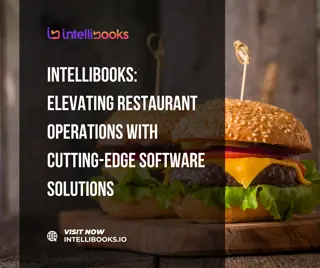Customer Service Training at Spices Restaurant
Understand the importance of customers, differentiate between internal and external customers, and meet their needs and expectations to provide excellent service. Learn about the significance of first impressions and how to create a positive experience for customers.
Download Presentation

Please find below an Image/Link to download the presentation.
The content on the website is provided AS IS for your information and personal use only. It may not be sold, licensed, or shared on other websites without obtaining consent from the author.If you encounter any issues during the download, it is possible that the publisher has removed the file from their server.
You are allowed to download the files provided on this website for personal or commercial use, subject to the condition that they are used lawfully. All files are the property of their respective owners.
The content on the website is provided AS IS for your information and personal use only. It may not be sold, licensed, or shared on other websites without obtaining consent from the author.
E N D
Presentation Transcript
Welcome To Spices Restaurant Customer Service Training Please ensure that your Cell Phones are off or on vibrate Thank You
Who are your Customers? For many of us customers are easy to identify. They buy something from us or we serve them in some way. But some people will say I don t work directly with customers. Before accepting this idea lets take a closer look at who our customers are.
Who are your customers? Internal Customers External Customers
Customers Needs They want to be understood. They want to feel welcome. They want to feel important. They want to feel comfortable.
Customers Need cont A customer is not dependent on us .We are dependent on him. A customer is not an interruption of our work .he is the purpose of it. We are not doing him a favour by serving him .he is doing us a favour by giving us the opportunity to so. A customer is not a person or someone to argue with. No body ever won an argument with a customer. Today s customer wants to deal with business professionals who are honest, trustworthy, competent and service oriented.
CUSTOMERS EXPECTATIONS To be valued by you. To feel comfortable and not pressured. To have undivided attention. For you not to make judgement about them. For you to focus on them rather than your paper work , computer or colleagues. For you not to ignore them in favour of someone you know.
First Impressions Do people buy from someone they dislike? Do you understand the power of a smile? Do you show sincere interest in your customer and engage in primary small talk? Do you grant time alone before asking for the order? Are you aware that a negative first impression may turn a prospect off to your product? Do you open with a sincere compliment? Do you promptly offer a refreshment and a comfortable seating arrangement?
First Impressions cont. Do you pay attention to your attire and personal grooming? Are you Pleasant and relaxed no matter the outcome?
Delivering quality guest service Quality Service is made up of two dimensions: The procedural Side: . Established systems and procedures to deliver products and services (skills and knowledge) The Personal Side: How service personnel All customer service Personnel using their attitude , behaviors and verbal skills to interact with customers.
Benefits Of Quality Service When you deliver quality service everyone wins.
Who benefits from quality service? THE GUEST Each guest arrives with certain concerns, emotions and expectations By providing quality guest service You have a chance to make a guest s day and stay a memorable one. THE PROPERTY If you exceeds guests needs, they will be more likely to return to the property. You have a direct impact on the property s success.
Who Benefits from quality service Your Co-worker When you do your job well, you make it easier for your co-worker to do their job well. You When you do your job well, you show co-workers and managers that you are a professsional. Good work is often rewarded with compliments and good job reviews.
SKILLS FOR MEETING AND EXCEEDING SERVICE EXPECTATIONS Guest come to your property for many reasons, some may have seen an ad describing the property or may have herd about it from friends. Others may have come before, enjoyed their stay and decided to return. Whatever the reason, guest expects certain things from you .
Guest expectations and skills PROFESSIONAL APPEARANCE Maintain a neat, well-groom appearance Wear a clean, proper uniform Wear your name badge FRIENDLINESS Smile Greet guest and co-workers promptly and happily Make eye contact
Guest Expectations and Skills COURTESY Give guest and co-workers your full attention Treat guest and co-workers with respect Call guest and co- workers by name FFLEXIBILITY Treat guest and co-worker as an individual Welcome each guest as a new opportunity to provide great service Offer creative solutions to meet guest and co-workers needs. Follow up with customers to ensure satisfaction.
Delivering quality service means creating a memorable experience for every guest by: Understanding and anticipating each guest wants and needs. Meeting and exceeding each guest wants and needs. Helping co-workers meet and exceed each guest wants and needs.
Basic quality service behaviours DO Introduce yourself, use guest and Customers name when ever possible Greet and acknowledge anyone who enters your work area or with whom you come in contact with at the hotel in a warm and friendly manner. Speak first and last to the customer Go the extra mile in providing service Give 100% service Keep customers informed Smile Respond promptly, apologize and Resolve. Pay attention to your tone of voice, Pay attention to your physical appearance. Be knowledgeable about your products and services.
Basic quality service behaviours DON T Carry on conversation with friends and co-workers in the presence of customers. Argue with guest or co-workers/customers Shout across a room or area at friends co-workers or guests Use negative expressions like that s not my job or I don t know to customers. Publicly critics guest co-workers or customers Eat or drink in the presence of customers
The Three As of Customer Service ATTITUDE APPEARANCE APPROACH
1. The Three As of Customer Service ATTITUDE Attitude affects our appearance, which influences our approach towards customers. Attitude: Positive- If we expect to do well we will be successful. Courteous Always be polite whatever the circumstance. Attentive Listen, show interest, be alert and observe customers; give them your undivided attention.
The Three As to Customers Service Attitude: Helpful You are there to provide a service, demonstrate that to your customers. Caring - Make Customers feel they matter, that they are individuals and not just one of the crowd. Enthusiastic Enjoy providing service and show customers you are happy to help; PUT ENERGY INTO IT.
The Three As of Customer Service Appearance: Dress - We should dress appropriately, be tidy and clean. We reflect the image of our organization. Voice Our tone of voice will convey ad much information to the customers as the words we use, must sound interested warm and sincere. Body Language Our gestures, posture and way in which we walk and sit will send information to customers. Smile It puts customers in a more receptive mood.
The three As Of Customer service Approach: Confident- If we approach the customer with confident we develop trust. Knowledgeable- The customer must feel that we know how to do our job; we are confident and efficient. Acknowledgment Always signal the customer's presence by looking at them and greeting them. Welcoming We all need to feel liked and approved of.
Body Language Signs and movements have a direct relation to out mood. A happy person will express happiness with his face and body movement s. Learning to understand body language will help us to order difficult situations and to anticipate the needs of our customers.
MOOD IDENTIFICAT THROUGH BODY LANGUAGE MOODS. SIGNS OF BODY LANGUAGE IMPATIENT: Pacing, tapping fingers, frequently looking around, playing with a credit card, getting in and out of a line, sighing, looking constantly at their watch. NERVOUS:. Trembling fingers/hands, touching the face frequently or playing with their ring. ANGRY: Crossed arms, tensed muscles, grinding teeth, sudden movements, making noises or playing roughly with things, hands on hip.
Dealing With Dissatisfied/ Challenging Guest Common causes of Guest / Customer Complaints Unprofessional staff Unmet expectations. Frustration. Delays waited extended period of time for service. Not being Informed. Broken Promises
Common causes of Guest/customer complaint No eye contact, ignoring the customer, minimal aid. Personal income and financial gain is above care for the client. Discrimination. Incompetence, lack of Knowledge, untrained staff. Poor communication, not listening. Unfairness/in even was of service. Failure to follow through no response to feedback.
The Cost of Losing a guest/ customer 1%-Die. 3%-Change Location. 5%- Make other friendships. 9%- Go to the competition 14%- Are dissatisfied. 68%-LEAVE BECAUSE OF BAD SERVICE!!
BE GLAD THEY TOLD YOU 96%- of unhappy guest never complain. The average unhappy customer will share the negative story with at least 10 20 other people. The average unhappy guest/customer will remember the incident for 23 1\2 months. The average happy guest/ customer will talk about the pleasant experience for 18 months.
HANDLING COMPLAINTS Skills for handling complaints LISTEN. Give the guest your undivided attention. Acknowledge the guest and the compliant. Empathize, let the get know you re concern about the problem. Ask questions to determine the exact complaint. Repeat the complaint in your own words to confirm understanding. Take notes.
HANDLING COMPLAINTS RESPOND. Thank the guest for bringing the matter to your attention. Apologize- say You re sorry for the inconvenience. Avoid placing blame, be sincere. Solve- Offer options and allow the guest to choose a solution. Take ownership of the problem . Explain to the guest what action you will take. Tell the guest when action will be taken. Set an approximate time frame for corrective action to be completed (be realistic)
HANDLING COMPLAINTS ACT. Take care of the problem yourself if possible. Contact the appropriate person/s to correct the problem. Monitor the progress of the people working with you on the problem.
HANDLING COMPLAINTS FOLLOW UP. CHECK BACK with the guest to ensure that the solution was satisfactory Report the entire event, action taken and conclusion to your manager or Supervisor.
HANDLING CHALLENGING & UNUSUAL GUEST SITUATIONS IRATE GUESTGUEST. Respond PROFESSIONALLY not personally. Stay Calm and Poised. Don t respond in kind. Deal with guest emotions.
BUSY SITUATIONS Don t get nervous. Remain calm. Acknowledge the other guest awaiting your assistance make eye contact, hand gesture, one moment please HELP IF PPOSSIBLE.
SPECIAL F & B SITUATION EARLY CUSTOMER Treat with courtesy, explain time for service and offer guest a beverage, cocktail, coffee, tea, etc. LATE CUSTOMER Make guest feel welcome. Offer a beverage and check with kitchen as to what items are available.
SPECIAL F&B SITUATION TIRED OR UNSURE CUSTOMER Be patient, don t rush, help guest order. OVER FAMILIAR GUEST. Avoid long conversations, go to the table only necessary. Do not crack jokes. GUEST WHO ARE ALONE. Give the guest your attention. Do not seat guest in quite corners on near kitchen entry doors. Serve guest quickly , do not hurry the guest.
HANDLING CHALLENGING/UNUSUAL GUEST SITUATIONS HOW TO DECLINE CUSTOMERS REQUEST OR STATE COMPANY POLICY. Listen to the entire statement even though you know you will say no. DON T SAY IT S COMPANY S POLICY. A. Empathize. B. Acknowledge. C. Decline with reason. D. Suggest an alternative. E.Ask open ended questions. Depersonalize the situation by reminding yourself their anger is directed at the system, not you personally.
TIPS FOR IMPROVING CUSTOMER SERVICE Greet your customers promptly and cheerfully. Talk to customers with Your eyes. Smile for your customers. A smile tells your customer that they have come to the right place and that they are on friendly turf. Pay attention to your personal appear and grooming.
Tips for improving Customer Service Check the appearance of your work area. Never miss the opportunity to say PLEASE and THANK YOU. Call people by their name. Listen with more than your ears. FOLLOW THROUGH.
TELEPHONE COURTESY We try to make every called feel important by being friendly, polite and professional on the telephone. Be prepared to answer the phone. SMILE it shows up in your voice. Speak clearly in the receiver. Use proper grammar and dictation avoid slangs and technical terms that the callers nay not understand. Avoid yep uh-huh and ok instead use yes, certainly, or absolutely .
TELEPHONE CIURTESY Answer the phone within three rings. A phone that rings more than three times gives the caller the impression that you do not want to take their call. Always answer the phone as per the property s Standard which is Good morning Thank You For Calling Species Restaurant ------ Speaking, how may I assist you . Always tell the caller your name and the name of the department. Give the caller a friendly greeting such as Good e or Good evening and ask how you may help him or her.
TELEPHONE COURTESY Give the caller your complete attention , pretend he or she is standard right in front of you. Talk to only to the person on the phone not any one else around you. If the call is for a manager, ask the caller if you can put them on hold ,.then get the manager immediately . Or take a message if necessary.
TELEPHONE COURTESY You will often be very busy when the one rings. To make a caller feel welcome catch your breath before picking up the phone. If you sound stressed or hurried the caller will also feel rushed. Something to take care of a request , you will need to put callers on hold . Providing good service means always asking callers if it s alright to put them on hold . If a caller gives you permission , take care of the request quickly . Thank the caller for waiting when you return to the line.
TELEPHONE COURTESY Always end each phone call with a sincere Thank You for calling ALWAYS let your caller hang up first the end of your call is your last chance to leave a good impression.
Wine Wine is made from Fermented Juice of freshly picked grapes, other fruits, or flowers and is usually classified according to color. Red wine have a red or purple color and are served at a cool room temperature. White wines have a pale color ranging, from straw to gold and are served chilled. These types of wine are also known as table wines.
Terms that apply to wine tasting Aging Storing wine before bottling Aroma The odor of a young wine usually fruity or flowery. Bouquet- The complex smell of a mature wine. Body The feel and weight of a wine in the mouth. Example light, medium or full bodied Dry- Not sweet. Vintage The year a wine s grape were harvested and wine making was begun.
Other wines you may serve in your restaurant Aperitif Wine Wine with spirits added and flavored with herbs and spices Example Vermouth Dessert Wine- Wine with spirits added but with no herbs and spices Example port and sherry Port- Dessert wine that normally ages at least 20 years. Sake- (sah-kee)- Japanese Rice wine Sparkling Wine- Wine containing carbon dioxide, which produces ingles when the wine is champagne is a sparkling wine produce from grapes grown in Champagne France
Other wines you may serve in the Restaurant Still Wine-Wine with no carbon dioxide or bubbles
WINE PRONUNCIATION Cabernet sauvignon-kab-ur-nay so-veen,-yon Champagne : Sham-pane Chardonnay:-Shar-duh-nay Merlot-mare-lo Pinot Noir : pee -no-nwar Rose : roe-zay Souvignonblanc : so- veen-yon blawnk Zinfandel: zin-fen-dell

























